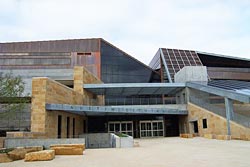Austin City Hall Goes Green with Copper
 Exterior and interior uses of copper helped Austin City Hall earn USGBC's Gold LEED certification.
Exterior and interior uses of copper helped Austin City Hall earn USGBC's Gold LEED certification.High-resolution version of this photo.
With its multiple angles and sharp curves, the unique four-story structure is clad almost entirely in brown-gold copper. Approximately 66,000 square feet of copper was used for the interior and exterior facades of the 115,000-square-foot building, which opened in late 2004 and cost $56 million to construct.
Recognized as an artistic as well as architectural achievement, Austin 's City Hall is a contemporary tribute to the city's storied past, but one that "lives" very much in its present environment while anticipating future change. Its design, by Pritzker Prize-winning architect Antoine Predock, draws heavily on the area's culture, landscape and environment to reflect the city's organic, growing, vibrant nature.
To retard the natural patination process that gradually transforms copper's shiny russet finish to dull brown and eventually to a soft, gray-blue green, a light oil coating was applied to the exterior cladding. Predock reportedly did this so the building would slowly accumulate the signs of aging and wear and tear, to better incorporate it into its natural surroundings. Specific areas of the copper interior wall and ceiling surfaces were alternately oiled to maintain their shine, chemically prepatinated to bring out the green color, or left to age and change naturally over time.
According to Paul Feahlu, Predock's associate and the lead designer on the project, "The great thing about copper, as it relates to Antoine's process, is that you see it age. Architecture moves through time, and copper allows you to see the building's time travels."
Inside the building, meeting and conference rooms are separated by glass partitions, evoking the open government and public accountability Austinites take pride in. In the auditorium that houses the City Council chamber, copper "clouds" on the walls and ceiling are both decorative and functional. While helping to create a more intimate setting within the large hall, the clouds also diffuse sound and reduce echoing.
In 2006, the City Hall building earned the coveted United States Green Building Council's Gold LEED Certification for its sustainable design qualities. The project obtained the gold status by meeting several different LEED green building guidelines, including its use of recycled and pre- and post-consumer materials such as copper in the building's construction.
"I am delighted that Austin City Hall , the community's cornerstone of democracy and civic involvement, has received this great recognition," stated Mayor Will Wynn. "Sustainability is a civic virtue that the city strives for in many different areas. It reflects our success, which is something that all Austinites can take pride in achieving."
Also in this Issue:
- Copper: Architecture’s Green ‘Enabler’
- Copper: An Element of Good Design
- Copper Rx for Sick Buildings
- Austin City Hall Goes Green with Copper
- Cold Fusion: Joining Copper Plumbing Without Heat
